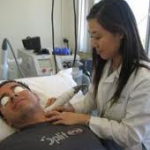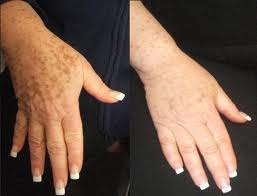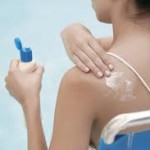Treatments and drugs
If you’re unhappy with the appearance of age spots, treatments are available to lighten or remove them. Since the pigment is located at the base of the epidermis — the topmost layer of skin — any treatments meant to lighten the age spots must penetrate this layer of skin.
Age spot treatments include:
- Medications. Prescription bleaching creams (hydroquinone) used alone or with retinoids (tretinoin) and a mild steroid may gradually fade the spots over several months. Sun protection with a broad-spectrum sunscreen with a sun protection factor (SPF) of 30 is strongly advised if you use medication treatments. The treatments may result in temporary itching, redness, burning or dryness.
- Laser therapy. Laser therapy destroys melanin-producing cells (melanocytes) without damaging the skin’s surface. Treatments with a laser typically require several sessions. After treatment, age spots fade gradually over several weeks or months. Laser therapy has few side effects, but it may result in slight discoloration of the skin.
- Freezing (cryotherapy). This procedure involves applying liquid nitrogen or another freezing agent to the age spots to destroy the extra pigment. As the area heals, the skin appears lighter. Freezing is typically used on a single age spot or a small grouping of age spots. The treatment may temporarily irritate the skin and poses a slight risk of permanent scarring or discoloration.
- Dermabrasion. This procedure consists of sanding down (planing) the surface layer of your skin with a rapidly rotating brush. This procedure removes the skin surface, and a new layer of skin grows in its place. Temporary redness and scab formation can result from this treatment.
- Chemical peel. A chemical peel involves applying an acid, which burns the outer layer of your skin, to the age spots. As your skin peels, new skin forms to take its place. Several treatments may be necessary before you notice any results. Sun protection is strongly advised following this treatment. Temporary irritation is likely, and there’s a slight risk of discoloration. The three main types of chemical peels in order of intensity are: AHAs, TCA, and Phenol. Phenol chemical peels are very powerful and are not recommended for darker skin tones. Most people with aging skin can benefit from AHAs, the mildest peel that can help remove rough patches and even out skin tone after just a few treatments.
Because age spot treatments are considered cosmetic, your insurance may not pay for them. And because the procedures can have side effects, discuss your options carefully with your dermatologist. Also, make sure your dermatologist is specially trained and experienced in the technique you’re considering.
Lifestyle and home remedies
Many fade creams and lotions for lightening age spots are available in department stores, in drugstores and on the Internet. These may improve the appearance of age spots, depending on how dark the spots are and how often you apply the cream. Regular use over several weeks or months may be necessary to produce noticeable results.
If you opt for an over-the-counter (nonprescription) fade cream, choose one that contains hydroquinone, deoxyarbutin, glycolic acid or kojic acid. Note that some products, especially those that contain hydroquinone, may cause skin irritation. Be alert to the type of creams and lotions you use on your face. There may be a product in it that does not suit your skin type and you will end up with age spots. Harsh chemicals also have the same reaction by the body which is to start the production of excess melanin which then results in brown spots and if the damage is a lot then you would need lots of treatment to set it right again.
Prevention
To help avoid age spots, follow these tips for limiting your sun exposure:
- Avoid the sun between 10 a.m. and 4 p.m. Because the sun’s rays are most intense during this time, try to schedule outdoor activities for other times of the day.
- Use sunscreen. Fifteen to 30 minutes before going outdoors, apply a broad-spectrum sunscreen that provides protection from both UVA and UVB light. Broad-spectrum sunscreens contain one or more of the following ingredients: avobenzone, cinoxate, ecamsule, menthyl anthranilate, octyl methoxycinnamate, octyl salicylate, oxybenzone, sulisobenzone, titanium dioxide or zinc oxide. Use a sunscreen with a sun-protection factor (SPF) of at least 15. Apply sunscreen generously, and reapply every two hours — or more often if you’re swimming or perspiring.
- Cover up. For protection from the sun, wear a broad-brimmed hat, which provides more protection than does a baseball cap or golf visor, and tightly woven clothing that covers your arms and legs. You might also consider wearing clothing designed to provide sun protection. An ultraviolet protection factor (UPF) of 40 to 50 provides the best protection. UV-blocking clothes can lose their protective feature if they are stretched, become wet or are washed repeatedly.



